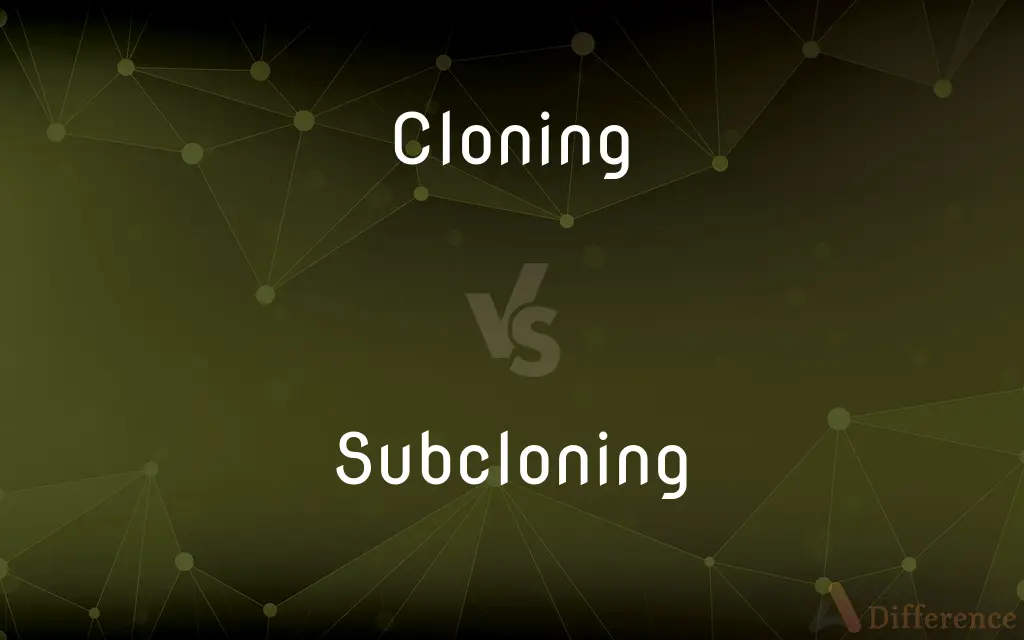Cloning vs. Subcloning — What's the Difference?
Edited by Tayyaba Rehman — By Fiza Rafique — Updated on September 27, 2023
Cloning involves creating an identical copy of an organism or DNA, while Subcloning is transferring a specific DNA fragment from one vector to another.

Difference Between Cloning and Subcloning
Table of Contents
ADVERTISEMENT
Key Differences
Cloning is a method in molecular biology where an exact copy of an organism or specific DNA segment is created. Subcloning, on the other hand, is a specific type of cloning where a certain fragment of DNA is transferred from its primary location in one vector (carrier DNA) to another vector.
Within the context of genetics, Cloning serves to reproduce entire organisms or to copy genetic materials, ensuring they are identical. Subcloning acts as a technique used for isolating specific genes or DNA sequences from larger molecules and placing them in more manageable or useful vectors.
Cloning can have broad applications, from therapeutic cloning in medicine to the creation of identical animals in livestock. It is a powerful tool in studying genes and their functions. In contrast, Subcloning is more of a specialized procedure in molecular biology labs, typically to facilitate the study or modification of a particular gene or DNA segment.
The central goal of Cloning might be to produce identical animals, reproduce a specific trait, or even duplicate cells for medical applications. Meanwhile, the objective of Subcloning is often preparative, setting the stage for further molecular experiments or manipulations on the DNA fragment of interest.
Comparison Chart
Definition
Creating identical copies of organisms or DNA
Transferring specific DNA fragments from one vector to another
ADVERTISEMENT
Scope
Entire organism or genetic material
Specific gene or DNA sequence
Applications
Reproduce organisms, study genes, medical uses
Study/modify specific genes, prepare DNA for further experiments
Vectors Involved
May or may not involve vectors
Always involves vectors (source and destination)
End Goal
Identical copy
Isolated or manageable DNA fragment
Compare with Definitions
Cloning
The process of making identical copies.
Scientists are exploring the potential benefits of cloning for organ transplants.
Subcloning
Facilitating the study of DNA segments.
Subcloning techniques are commonly used in molecular biology labs.
Cloning
Molecular technique for copying DNA.
Cloning helps in amplifying the desired DNA sequence for research.
Subcloning
Process of segmenting larger DNA molecules.
Subcloning helps in breaking down complex DNA structures for study.
Cloning
Creating exact genetic duplicates.
Cloning can be used to conserve endangered species.
Subcloning
Transferring DNA between vectors.
Subcloning allows researchers to study specific genes more easily.
Cloning
Reproduction without sexual means.
Cloning can produce genetically identical organisms.
Subcloning
Molecular technique for isolating DNA fragments.
Subcloning is essential for genetic engineering applications.
Cloning
Cloning is the process of producing individuals with identical or virtually identical DNA, either naturally or artificially. In nature, many organisms produce clones through asexual reproduction.
Subcloning
Relocating specific genes to new vectors.
Through subcloning, genes can be placed in expression vectors for protein production.
Cloning
A group of cells or organisms that are descended from and genetically identical to a single progenitor, such as a bacterial colony whose members arose from a single original cell.
Subcloning
In molecular biology, subcloning is a technique used to move a particular DNA sequence from a parent vector to a destination vector. Subcloning is not to be confused with molecular cloning, a related technique.
Cloning
An organism developed asexually from another and genetically identical to it, such as an animal produced from an egg cell into which the nucleus of an adult individual has been transferred.
Subcloning
Present participle of subclone
Cloning
A DNA sequence, such as a gene, that is transferred from one organism to another and replicated by genetic engineering techniques.
Subcloning
The production of a subclone
Cloning
One that copies or closely resembles another, as in appearance or function
"filled with business-school clones in gray and blue suits" (Michael M. Thomas).
Cloning
To make multiple identical copies of (a DNA sequence).
Cloning
To create or propagate (an organism) from a clone cell
Clone a sheep.
Cloning
To reproduce or propagate asexually
Clone a plant variety.
Cloning
To produce a copy of; imitate closely
"The look has been cloned into cliché" (Cathleen McGuigan).
Cloning
To grow as a clone.
Cloning
Present participle of clone
Cloning
The production of an exact copy of an object.
Cloning
(biology) The production of a cloned embryo by transplanting the nucleus of a somatic cell into an ovum.
Cloning
A general term for the research activity that creates a copy of some biological entity (a gene or organism or cell)
Cloning
Reproducing organisms using cells.
Some believe that cloning can revolutionize medicine in the future.
Common Curiosities
What is the primary vector use in Subcloning?
Subcloning involves transferring DNA from a source vector to a destination vector.
Can Cloning create an exact genetic replica?
Yes, cloning can create genetically identical organisms or DNA.
What is the main purpose of Cloning?
Cloning aims to produce identical copies of organisms or genetic material.
Is Subcloning a type of Cloning?
Yes, Subcloning is a specialized form of cloning to transfer specific DNA fragments.
Why use Subcloning in laboratories?
Subcloning aids in studying, modifying, or isolating specific genes or DNA segments.
Are the ethical concerns related to Cloning?
Yes, cloning, especially of whole organisms, has raised various ethical debates.
Can Cloning help in medical research?
Yes, therapeutic cloning can potentially aid in treatments and organ transplants.
Has Cloning been used on animals?
Yes, animals like sheep (Dolly) have been successfully cloned.
Does Cloning have agricultural applications?
Yes, cloning can produce livestock with desired traits.
Is Subcloning only limited to DNA?
Subcloning primarily focuses on specific DNA fragments, not entire organisms.
What's the difference between the vectors in Subcloning?
In subcloning, a DNA fragment is moved from a primary/source vector to a secondary/destination vector.
Can Cloning bring back extinct species?
Theoretically, with preserved DNA, but there are technical and ethical challenges.
Can Cloning reproduce human beings?
Technically possible, but there are significant ethical, legal, and biological concerns.
Is Subcloning necessary for genetic engineering?
It's a valuable tool, allowing specific genes to be placed into useful vectors for manipulation.
How does Subcloning facilitate gene expression?
Subcloning can place genes in expression vectors, allowing protein production in host cells.
Share Your Discovery

Previous Comparison
Hunt vs. Haunt
Next Comparison
Earlier vs. EarlyAuthor Spotlight
Written by
Fiza RafiqueFiza Rafique is a skilled content writer at AskDifference.com, where she meticulously refines and enhances written pieces. Drawing from her vast editorial expertise, Fiza ensures clarity, accuracy, and precision in every article. Passionate about language, she continually seeks to elevate the quality of content for readers worldwide.
Edited by
Tayyaba RehmanTayyaba Rehman is a distinguished writer, currently serving as a primary contributor to askdifference.com. As a researcher in semantics and etymology, Tayyaba's passion for the complexity of languages and their distinctions has found a perfect home on the platform. Tayyaba delves into the intricacies of language, distinguishing between commonly confused words and phrases, thereby providing clarity for readers worldwide.
















































